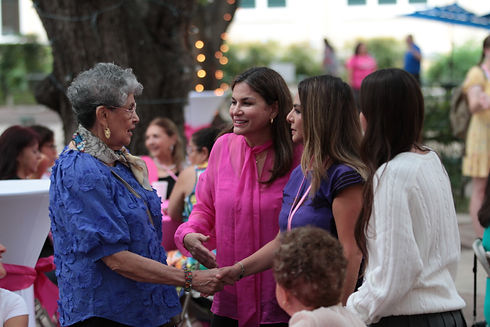
Hispanas Unidas began in the early 1980s when a group of Latina women led by the Hon. Maria Antonietta Berriozábal came together to plan the first Hispanas Unidas Conference—a powerful gathering that celebrated Latina leadership, culture, and activism. The success of that event sparked something greater: a desire to keep the momentum going and create a lasting space for connection, learning, and collective action.


What started as a conference grew into a vibrant, intergenerational network dedicated to empowering Latinas and advancing justice in our communities. For over 40 years, Hispanas Unidas has brought together students, professionals, community organizers, and elders to lead with purpose, celebrate our heritage, and build power from the ground up.
Rooted in sisterhood and guided by corazón, we continue to nurture the next generation of Latina leaders while honoring the vision of the mujeres who started it all.
Understanding The
Latina Experience
Latinas are a growing force in the United States—shaping culture, driving economic progress, and leading change in our communities. Yet, despite their contributions, Latinas continue to face systemic inequities in education, health, income, and representation. These facts offer a snapshot of the challenges and strengths that define the Latina experience today. By understanding the data, we move one step closer to equity, justice, and empowerment for all.
Economy & Workforce
-
Latinas are paid just 52 cents for every $1 earned by white, non-Hispanic men, one of the largest wage gaps in the country.
- National Women's Law Center, 2023 -
Latinas are the fastest-growing group of women entrepreneurs in the U.S.
Between 2007 and 2019, the number of Latina-owned businesses grew by over 87%.
- Stanford Latino Entrepreneurship Initiative, 2020
Latina GDP
-
In 2021, U.S. Latinas contributed approximately $1.3 trillion to the U.S. Gross Domestic Product--equivalent in size to Florida's entire economy--and representing about 5.6% of total U.S. GDP
-
Between 2010 and 2021, Latina GDP grew 51.1%, nearly three times faster than non-Hispanic GDP (18.8%)
- UCLA Latino GDP Report, 2024
Education
-
High school graduation rates for Latinas reached 90% in 2022, up from 60% in 2000.
- U.S. Census Bureau, 2022 -
College enrollment for Latinas is at 68%, higher than their male counterparts and on par with white women.
- National Center for Education Statistics, 2022
Latina Consumer Control
-
86% of U.S. Latinas report controlling household spending, reflecting dominance over a substantial portion of consumer dollars, estimated at over $1.2 trillion annually
- 2025 Official LDC U.S. Latino GDP report
Demographics
-
Latinas make up over 9% of the U.S. population and more than 18% of all women and girls in the U.S.
- Pew Research Center, 2023 -
Median age of Latinas is 30, compared to 43 for white women — a reflection of youth and future influence.
- Pew Research Center, 2023
Health & Wellness
-
Latinas have higher rates of chronic conditions like diabetes and obesity but are less likely to have access to quality healthcare.
-Office of Minority Health, U.S. Dept. of Health & Human Services -
Nearly 1 in 3 Latinas are uninsured, the highest rate among women of any major racial/ethnic group.
-Kaiser Family Foundation, 2022
Leadership & Representation
-
Latinas are underrepresented in leadership roles, holding only 2% of seats on Fortune 500 boards.
- Latinas Represent / Latino Corporate Directors Association, 2023 -
As of 2023, just one Latina has ever served in the U.S. Senate (Catherine Cortez Masto, NV).
- U.S. Senate Historical Office


